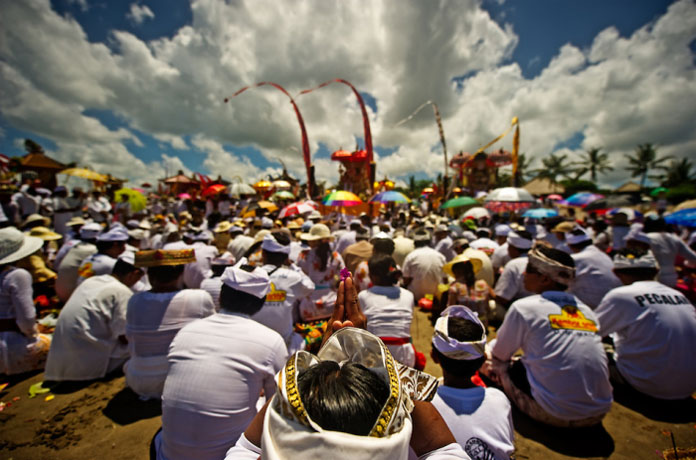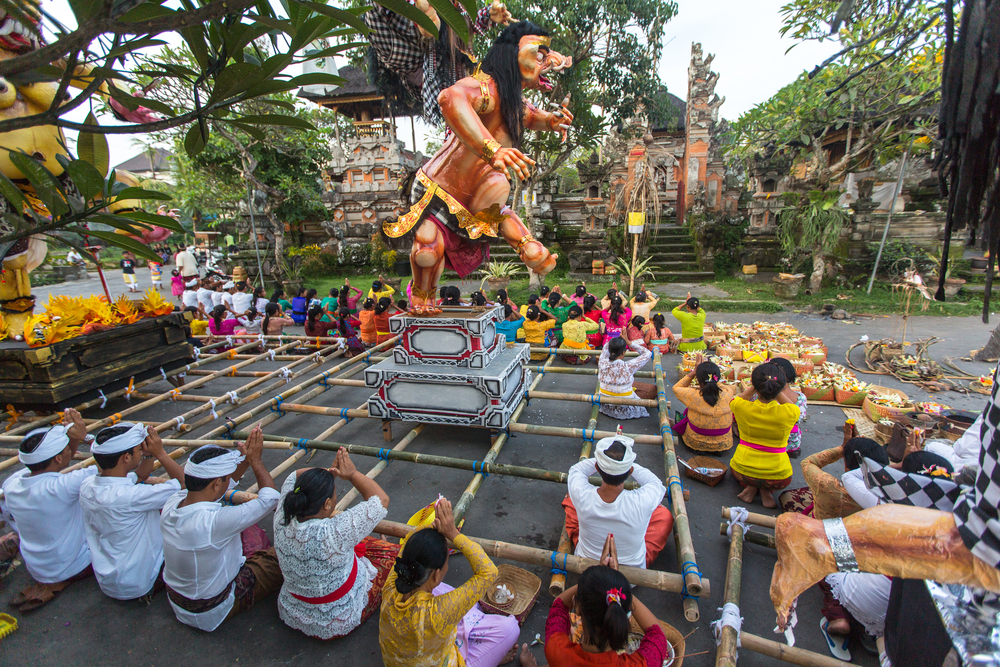On the night of Nyepi, at the stroke of midnight, all of Bali will retreat into silence for 24 hours. On this day of the new moon but darkest of all nights Hindus here will not cook, work, travel or indulge in sex in a collective attempt to purify the entire island.
There will be no flights into Bali or out on this day and none will pick up the telephone. Shops will remain closed and all streets deserted. No light will be switched on even after the sun has set, as the island involves itself in mass meditation to restore balance between the forces of evil and good. If visitors who are already in Bali are lucky then the only glow visible to them on this dark and quiet night will be from countless stars that often speckle the vast blue skies.
Nyepi is an ancient festival marking the New Year when it is believed that the three heavenly bodies of the earth, moon and sun are at their nearest proximity with the sun being directly above the equator, moving from the southern to the northern hemisphere. On this day Yama or the lord of hell is said to open wide all the gates of his domain to let loose a horde of devils upon Bali.
A few days before Nyepi the Balinese work themselves into a state of great excitement erecting altars at every crossroad and placing mouth-watering offerings to lure the devils out of the den. Brahman high priests sit under colorful scaffolding waiting for the devils to near the offerings before they expel the greedy monsters away from the island with powerful spells and mantras. Large processions crowd the streets minutes before the moment of silence begins. The beating of gongs, cymbals and drums is loud and boisterous as the gigantic ogoh-ogoh monsters, handmade in papier mache, are paraded around. All the noise and din is supposed to awaken the demons that may have already made a home in Bali in the past year and to bring them out into the open. As the sun sets the paper monsters are set on fire on riverbanks in a symbolic gesture of the retreat of evil from the island.
Other processions proceed towards the nearest beach along with thousands of Balinese dressed in ceremonial clothes, carrying heirlooms and the community deity from the village temple to the sea, lake or holy springs for a ritual cleansing. This is also the time to celebrate the end of the six month long and very troublesome rainy season that is said to make even the earth warm, and feverish.
Even before Hinduism was brought to Bali by Javanese kings fleeing their throne overrun by Islam, the primitive Balinese had already surrounded themselves with gods, demons and the deified spirits of their ancestors said to dwell at the tip of active volcanoes that form the island. The Balinese will tell you that human beings live in the middle world on the land that is between the top of a mountain and the sea which is home of enemies like devils and deadly giants. To this day they believe that they are sandwiched between two opposing forces of the positive mountains above and the negative ones of the underworld. And the purpose of their entire life is to try and create harmony with their existence and the natural forces, eternally divided into pairs, of male and female, right and left, high and low, strong and weak, sacred and unholy, good and evil, and life and death. It is not just the good forces that are worshipped but evil has also to be appeased. So the entire culture of the island is geared towards elaborate cults of ancestors, the worship of deities of fertility, fire, water, earth, sun, mountains, sea, gods and devils too along with Hindu gods that do reign supreme. The religion here is referred to as Hinduism but on closer observation it seems to be perhaps closer to the earth and much more animistic than the religion practiced by the Hindus of India.
By Mehru Jaffer






